
Of the canonical five, the confirmed victims of Jack the Ripper, it may be Elizabeth Stride who was the least likely. But her trajectory differs little from the others.
A fresh-faced Swedish country girl gone to Gothenburg at 15 as a domestic servant, expelled from her work because she was pregnant, a descent through the institutions devoted to the fallen, the loss of her baby, the last option being the “street of many nymphs” , then traded to England carrying the syphilis that would ruin her mind in the dark streets of Spitalfields.
They all started in different places. Elizabeth in Gothenburg, Anne’s mother an army dollymop, a camp follower. Kate’s family were sufficiently well-off to have her educated, Polly born in Fleet street, printers ink in her blood. And then there’s Mary Jane, no one knew where she came from and she made sure to keep it that way, but well spoken and intelligent as she was she went the same way as the others. The Whitechapel slums had space for all the ruined.
The society, politic, moral and physical textures of the time are skilfully researched and drawn
The Victorian press cast them all as prostitutes, and the kips of London the places where they “plied their hideous trade”, where a woman abandoned herself to sensuality and who becomes unsexed in her manners.
But what they held in common was not an abandonment to sensuality, the unchecked female nature run amok. It was women who became untethered from societal norms, who became subject to a legislative and social machinery that crushed them in their own lives and in their own hearts, the judgment of society rendered into self-judgment.
Annie Chapman’s husband had a good job as a senior coachman. She lost six of her eight children. She was an alcoholic, lost to drink. You can’t put the pieces of dependency together at such a distance. But the photographs embedded in the text of her sombre little girls in chenille and lace, their eyes fixed on something far beyond the camera, can only haunt.
There are eerie echoes of the “Nude Murders” of 1960s London, of David Peace’s Yorkshire, Gordon Burn’s texts on the Yorkshire Ripper and Fred and Rosemary West, the 2006 Ipswich murders. You can’t say there is something particular to the English imagination about these murders, but you can’t say that there isn’t. Fred West’s vile longings oozing up from the fens of Marston or Saddleworth moor, something rank and unresolved in the desire to reach inwards and undo, to desecrate the feminine.
There are echoes of the murder of Patricia Curran, the miasma of transgression descending on the dead women, that somehow she was the agent of her own undoing. Nothing much has changed in that regard.
Negative space
Reconstruction of a life is an impertinence. Hallie Rubenhold interposes speculation between the lens and the subject, what one of the women may have done, or what she may have thought, but mostly she operates in negative space.
The society, politic, moral and physical textures of the time are skilfully researched and drawn, creating an outline of each woman which she then fleshes out from what we know about each. Alcohol is a factor in all cases, most of the women were in poor health, trading a quick grope for a glass of gin or a corner to sleep in. The Ripper was no cunning and demonic force of nature. His victims were infirm street sleepers, unconscious with drink and almost entirely helpless.
The real demon lies in hypocrisy, the streets and parks of London teeming with the well-to-do pack hunting women driven into prostitution; Victorian morality gone feral in the parklands of the city the real degeneracy, while genuine pathos resides inStride, howling in the slums, her brain rotted with neurosyphilis.
Mary Jane Kelly became Marie Jeanette, sweetheart of the Café de l’Europe and other high-end establishments. She was traded across the channel but managed to escape the maisons close of Paris where the same entrapments of debt and physical violence pertained as they do now. And the pimps wanted revenge. She had to swap the gay houses of London for the filthy sailor’s den of the Ratcliffe Highway.
Rubenhold doesn’t idealise. She lets the woman’s existence and circumstance speak for itself. Stride portrayed herself as having lost her family in the Princess Alice drowning disaster, trading off other’s misery for cash. There are glimpses of lives eked out, people allowed to enfold themselves in their own humanity. Their vivid lives before the spiral into degradation.
Kate took up with a travelling chapbook salesman, the Irish man Thomas Conway, and they made a living as a patterer and chaunter, travelling across country with Kate singing the verses and Conway selling them. Mary Ann “Polly” Nichols was last seen wearing a Jolly Straw Bonnet edged with black velvet.
When Mary Jane’s body was found she was wearing a corsage pinned to her bodice of a single red rose tied together with maidenhair fern. The last song that Kate was heard to sing was A Violet From Mother’s Grave.











